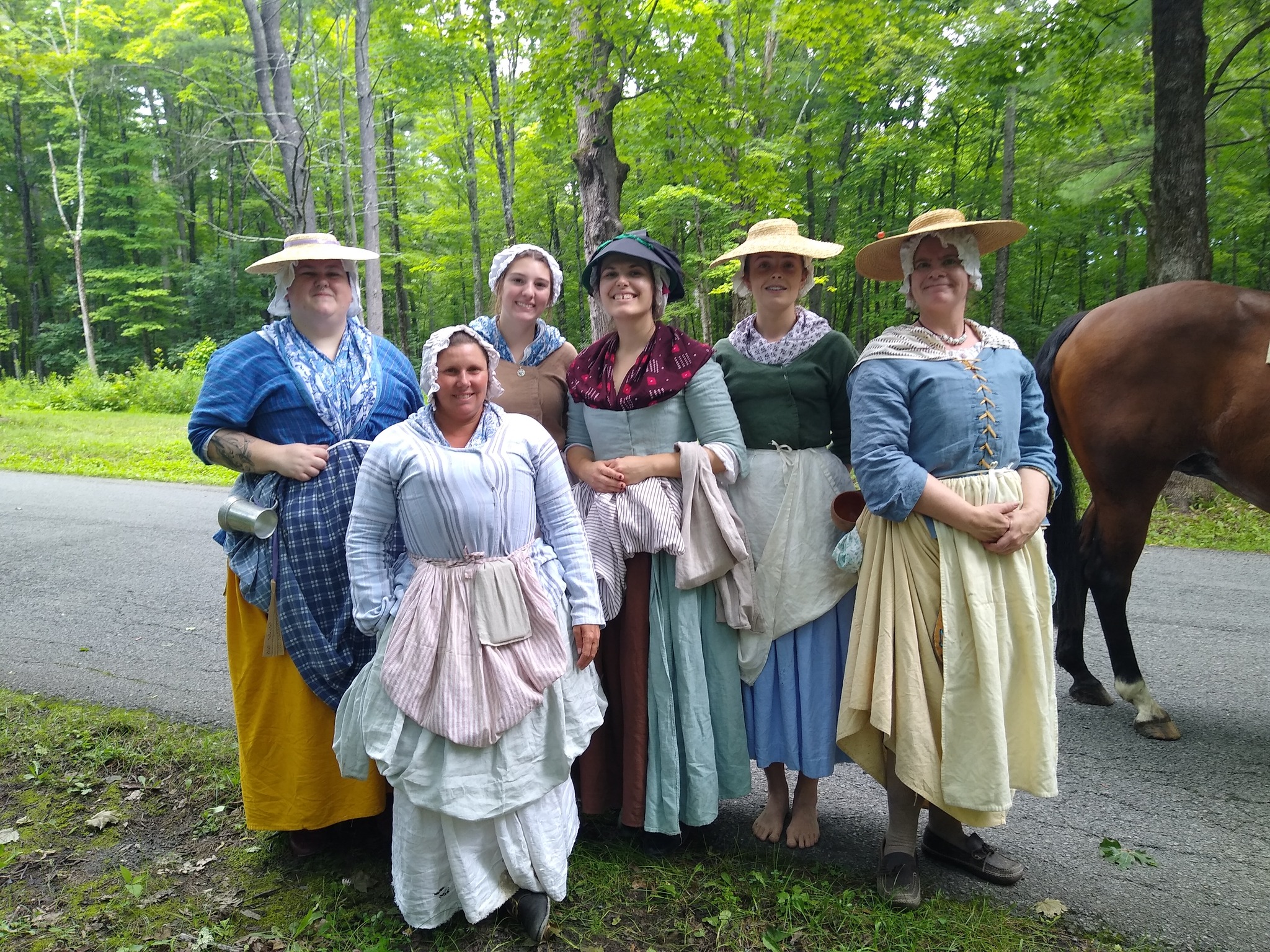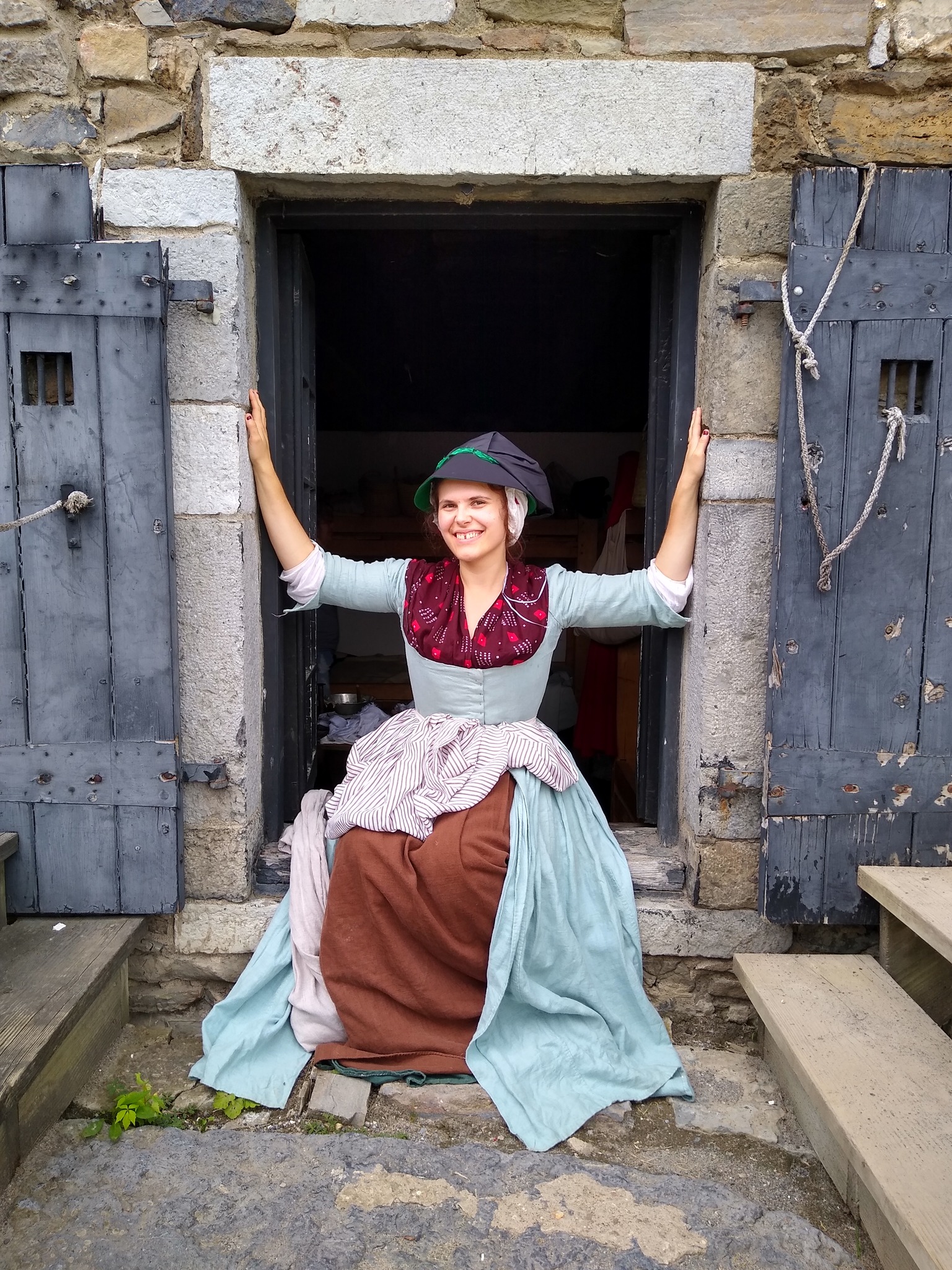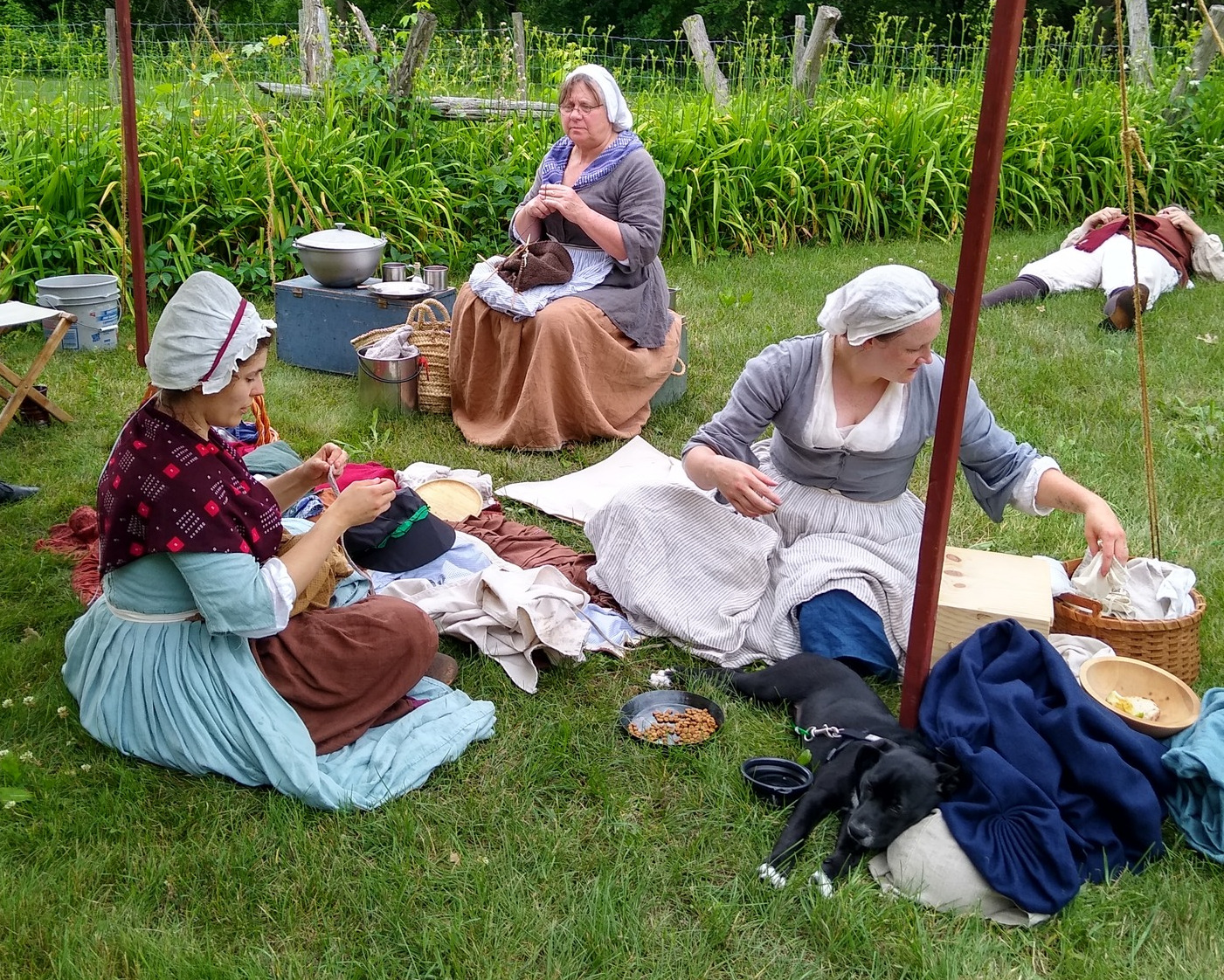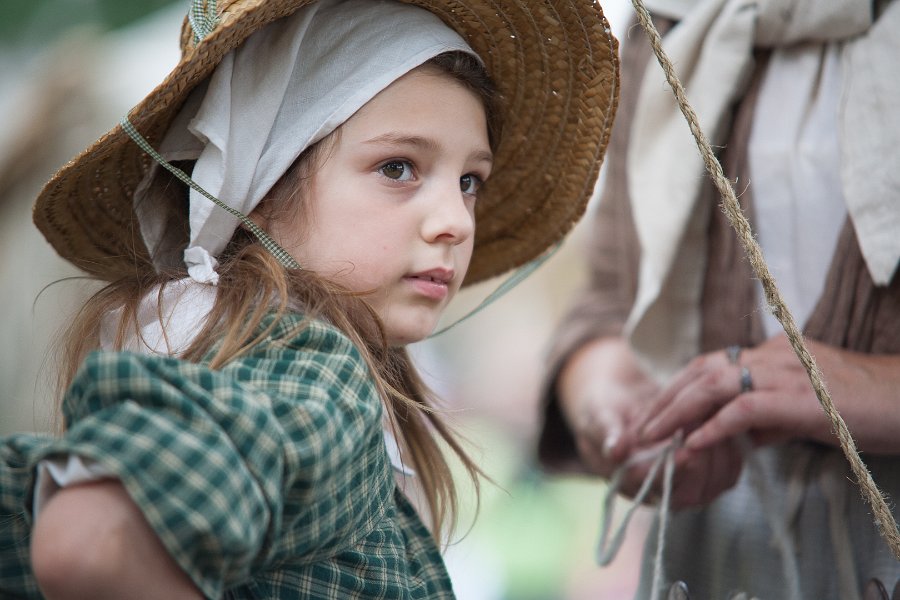
Distaff
Traditionally, the word "distaff" referred to women and women's activities. During the American Revolution, woman and children, often with nothing more than what they could carry, woud sometimes attached themselves to the Continental army for the protection of their families and to offer their services as seamstresses, laundresses, or petit sutlers.
The Regiment provides comprehensive tutorials with vetted fabrics, colors, and patterns correct for our portrayals to help you build your kit accurately. Members are expected to assemble their kit in accordance to these tutorials. See the Distaff Coordinator for more information.



Women's Clothing
| Shift – | The basic underwear for 18th Century women, in effect a washable liner for her outer clothes. Worn long, about nightgown length, it covers from neck to below the knee, sometimes it had a small ruffle at the neck and cuffs, but did not show much above the neckline. Fabric: 3.5-7 oz. linen, cotton, or occasionally flannel wool. NO printed patterns. |
| Petticoat – | Worn to a few inches above the ankle for working women. Generally tied around the waist, some use a drawstring. Under-petticoats worn two or more at a time for warmth depending on the season. Older, worn petticoats were worn under a newer or more fancy top-petticoat for show. Petticoats did not have sewn in pockets, but had long slits in the sides to access pockets worn under the top-petticoat. Fabric: various weights of striped linen or wool, or cotton prints. |
| Short Gown, Bed Jacket, or Gown – | A top layer garment -- a long gown (dress) or short gown or jacket. Put on like a coat and fastened in the front with pins or held closed by an apron. Fabric: 4-8 oz linen, linsey-woolsey, worsted or flannel wool, or cotton print. |
| Apron – | Worn over the petticoats to keep them clean while working and may have a bib to protect the short gown. Fabric: 5-14 oz plain, checked, or colored linen or cotton. Blue and black were popular colors. Heavier weights made sturdier aprons.. |
| Cap – | Worn to cover the hair while working; a woman without a cap was considered undressed. There are several styles of caps most worn with a ribbon around it. Fabric: 2.8-3.7 oz. white or off-white linen or cotton. The drawstring cap sold as a mobcap or mop cap is incorrect. |
| Stockings – | Wool or linsey-woolsey of just about any solid color. Horizontal striped stockings are not appropriate - they were not popular until the 1790's. |
| Garters – | Linen tape tied to hold up the stockings. |
| Shoes – | Plain black flats or tie shoes are good to start with. Rough side out for lower class impression, smooth side out for higher class. May be buckled or tied. Men’s style may be easier due to cost or fit. Simple center-seamed moccasins may also be worn. |
| Hat – |
A straw or felted hat worn over a cap in public. 18 |
| Stays or Jumps – | Undergarments for support & defining a woman's shape - the 18th century equivalent of a sports bra. Worn over a shift, under gown or short gown. |
| Kerchief – | Worn on the neck & tucked in to the shift for modesty or protect against sun burn. Size varied from 12x12” to 36x36”. Solid color or checked linen, cotton or silk. |
| Pocket(s) – | Worn under the top-petticoat and tied at the waist, a single or pair of bag like pockets about 20” long and 10-12" wide with a slit in the front. Fabric: plain linen or cotton, may be embroidered. |
| Cloak – | Outermost garment for cool weather and is handy as as a second blanket. Fabric: heavy weight, solid color, worsted or broadcloth wool with 11 oz Russia sheeting if a lining is desired. |
Excellent resources for woman's clothing are:
• Somen's Dress during the American Revolution: An Interpretive Guide by the Brigade of the American Revolution.
• Whatever Shall I Wear? by Mara Riley.
• La Couturière Parisienne: 1700s
•Demode: extant women's clothing, 1600-1919
For in depth information on woman's clothes two recommended books are Fitting and Proper by Sharon Ann Burnston, and Costume Close-up by Linda Baumgarten.
Patterns of Fashion 1 by Janet Arnold contains patterns from actual 18th century garments

Equipment
| Basket – | • Wicker or other woven containers to carry personal items. |
| (Market) Wallet – | A long, narrow, sack with a slit down the center to carry sundry personal items. With a half-twist to close the opening, it is thrown over the shoulder. Plans for a wallet are described in The Packet.1 |
| Blanket(s) – | Moderate weight & natural wool color or dyed dark color. If using a procured military issued blanked, the weight was lighter than what a civilian would have at home. Whitney & Hudson Bay type blankets while very warm on cold nights, are inappropriate for public display. |
| Housewife (Hussif)) – | A small pocket sewing kit, often made of scrap fabric. |

Clothing - Infant to age three
Through age 3 children of both sexes were attired similarly in long shirts/shifts to cover their baby clouts (diapers). Boys remained in long shirts until age 5 or 6 when they were "breeched," and began wearing more masculine clothing.
| Shift or Shirt – | Same basic patterns as adult shift & shirt, could be calf length. Fabric: 3.5-7 oz. linen, cotton, or occasionally flannel wool. NO printed patterns. |
| Tunic or Frock – | Outermost garment for protection from cold & inclement weather. Fabric: 5.5 - 12 oz. linen. Occasionally 12 oz. ticken or 12.5 oz. Russian drill. Tan/natural linen or brownish-greenish are most appropriate, but blues, rust, & yellow are acceptable. |
| Hat or Pudding Cap – | Pudding caps were a form of protective headwear, made from padded panels, sometimes worn by children as they learned to walk. |
| Moccasins – | During the summer months, children were usually unshod - but center seam moccasins are appropriate. |


Girls clothing - Ages 4 to puberty
After age 4, girls clothing began to follow the same patterns and styles as adult clothing.
| Shift – | Same pattern and fabric as adult shifts. |
| Gown or Short Gown – | Until puberty, young girls wore gowns which fastened in the back, then they dressed like their mothers. Fabric: 4-8 oz linen, linsey-woolsey, worsted or flannel wool, or cotton print. |
| Petticoat – | Fabric: 4-8 oz linen, linsey-woolsey, worsted or flannel wool, or cotton print. |
| Stockings – | Wool or linsey-woolsey of just about any solid color. Horizontal striped stockings are not appropriate - they were not popular until the 1790's. |
| Shoes – | During the summer months, children were usually unshod - but center seam moccasins are appropriate. |
| Apron – | Same pattern as adult aprons. Fabric: 5-14 oz plain, checked, or colored linen or cotton. Blue and black were popular colors. Heavier weights made sturdier aprons. |
| Pocket – | Worn under the top-petticoat and tied at the waist, a single or pair of bag like pockets. Fabric: plain linen or cotton, may be embroidered. |
| Cap – | Same cap styles as for adult women. Fabric: 2.8-3.7 oz. white or off-white linen or cotton. |
| Cloak – | Same pattern as adult cloaks. Fabric: heavy weight, solid color, worsted or broadcloth wool with 11 oz Russia sheeting if a lining is desired. |

Boys clothing - Ages 4 to puberty
After boys were "breeched" around age 5, their clothing follows adult patterns and styles.
| Shirt – | Same style as adult shirts. Fabric: 5-6 oz. linen or cotton. White, natural linen, light brown, or checked colors are appropriate. |
| Breeches – | Same style as adult breeches. Fabrics: ~12 oz. linen, ticken, or Russia drill. Light brown preferred, white, blue, white with blue striped ticking are appropriate colors. |
| Waistcoat – | Same style as adult waistcoat. Fabric: linen or light to medium wool. Light brown, green, gray, or white are appropriate colors. |
| Hat – | Felted flat brimmed hat or cocked on 3 sides. Generally untrimmed. Knitted "Monmouth" style cap. |
| Shoes / Moccasins – | Plain black shoes are good to start with. Rough side out for lower class impression, smooth side out for higher class. May be buckled or tied. Simple center-seamed moccasins may also be worn. |
1 The Packet: Being a Collection of Patterns, Articles, and Essays Pertaining to the American Revolution. By Mark R. Tully. Ballindolloch Press.1999-2007.
